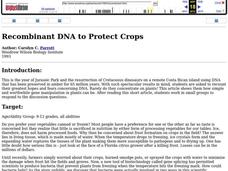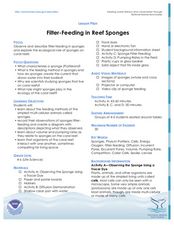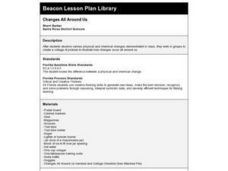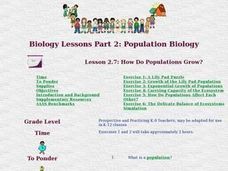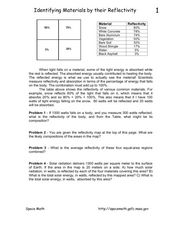Curated OER
Fizzies Virus
Young scholars participate in a simulation activity about how disease spreads. They describe how disease spreads and trace a disease to the first infected person.
Curated OER
Recombinant DNA to Protect Crops
Learners are asked to recount their greatest hopes and fears concerning DNA. One article states how worthwhile gene manipulation in plants can be. Classroom discussions arise after reading one article on this issue.
Curated OER
States of Matter and Chemical/Physical Changes Stations
Students break into four groups, starting at different stations. Each station should take about 10 minutes depending on prior knowledge of the topic. They then rotate when everyone is finished to the next station and discuss answers of...
Curated OER
Combating Corrosion
Students perform an experiment to show the chemical reactions that occur when metal corrodes. They apply the results of the experiment to the conservation efforts of art curators trying to restore an ancient Greek bronze. This lesson...
Curated OER
Molarity Labs I & II $ III
In this molarity lab worksheet, students write down the process they took to determine the molarity of a given sample of a solution of salt. They also make two particular molar solutions in the lab and show their calculations. They answer
Curated OER
Planets Worksheet
In this planets worksheet, students use Internet research to complete 5 pages about solar system facts. Students answer 25 essay questions and label a diagram of the solar system.
Curated OER
Filter Feeding in Reef Sponges
Students investigate the role of sponges in our oceans. In this biology lesson plan, students create a diagram visualizing how sponges bring food into their bodies through a filtering process. Students discuss the connections...
Curated OER
Osmosis and Diffusion: Egg Lab
Students examine why diffusion and osmosis happen in an egg cell. In this diffusion activity students demonstrate a semi permeable membrane.
Curated OER
Filter-Feeding in Reef Sponges
Learners make observations and describe the filter-feeding in sponges as it relates to the ecological role of sponges on coral reefs. In this filter-feeding in reef sponges lesson plan, students are introduced to the feeding methods of...
Creative Chemistry
How to Use the Burette
In this burette-use activity, students are given directions for titration using a burette. They practice reaching the end point of titrations and calculate the mean volume of three trials.
Curated OER
How Does Your Garden Grow?
Young scholars examine birdseed to see if it is a fertilized seed. In this birdseed garden lesson, students experiment with birdseed on a sponge to see what grows. Young scholars record the growth of seeds.
Curated OER
An Introduction to Chemistry
In this introduction to chemistry activity, students complete 48 problem solving and fill in the blank questions. They convert measurements from one unit to another.
Creative Chemistry
How to Use the Burette
In this burette activity, learners learn how to use a burette to perform a titration properly and run four trials, indicating their data. Students calculate the initial volume, the final volume, the titre volume, and the mean titre...
Curated OER
Mapping a Stream
Students map an actual local waterway. They create full color scale drawings that include windfalls, plant cover, streambed composition, and landmarks such as trees, boulders, and slumps. This is a long-term project that involves...
Curated OER
Volcano Hazards
Students research volcano hazards in VolcanoWorld, make a paper volcano, produce and watch the effects of ashfall, produce and watch the effects of a mudflow and create a hazard map by plotting historical ashfall/mudflow data from Mount...
Curated OER
A Comparison of Polymeric Liquids with Newtonian Liquids
Students concretely illustrate and define a macromolecule, observe the unique behavior of polymers and relate to their knowledge of molecules, and use the scientific process to determine the difference between Newtonian and non-Newtonian...
Curated OER
Changes All Around Us
Sixth graders, in groups, observe the difference between physical and chemical changes and create a collage of pictures to show the difference.
Curated OER
How Do Populations Grow?
High schoolers examine how populations grow and how invasive species can affect the balance of ecosystems. They simulate the growth of lily pads, analyze and record the data, and simulate the results of an invasive species on an ecosystem.
Curated OER
Ready, Set, Let's Dough! It's a Matter of System
Young scholars will look at a complex system when they create their own play dough by taking several parts and creating a whole. The students will construct understanding that individual parts are used to make a whole.
Curated OER
Our Changing Community
Students investigate how communities grow and change. In this communities lesson, students discuss how their community has changed and construct a model of a community.
Curated OER
Air Is there
Young scholars experiment to observe air and its mass. In this air lesson, students use the scientific method to complete experiments that demonstrate the properties of air. Young scholars view a video as follow-up.
Creative Chemistry
Rates of Reaction: Indigestion Remedies
In this reactions learning exercise, high schoolers compare the reaction of two different indigestion tablets with dilute hydrochloric acid and plot the mass loss results against time. Then, they complete five short answer questions.
Curated OER
Identifying Materials by their Reflectivity
In this reflectivity worksheet, students read about the absorption and reflectivity of light by different materials. Students solve 4 problems and determine the composition of given materials based on the amount of light reflected. They...
Curated OER
What Did I Touch Today?
Students investigate germs and how they travel. They graph the places in the classroom that have been touch by students to determine which five places have had the most contact. They write stories from a germ's point of view.

